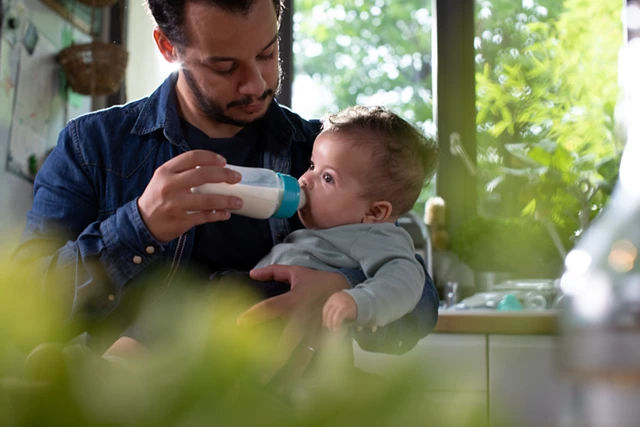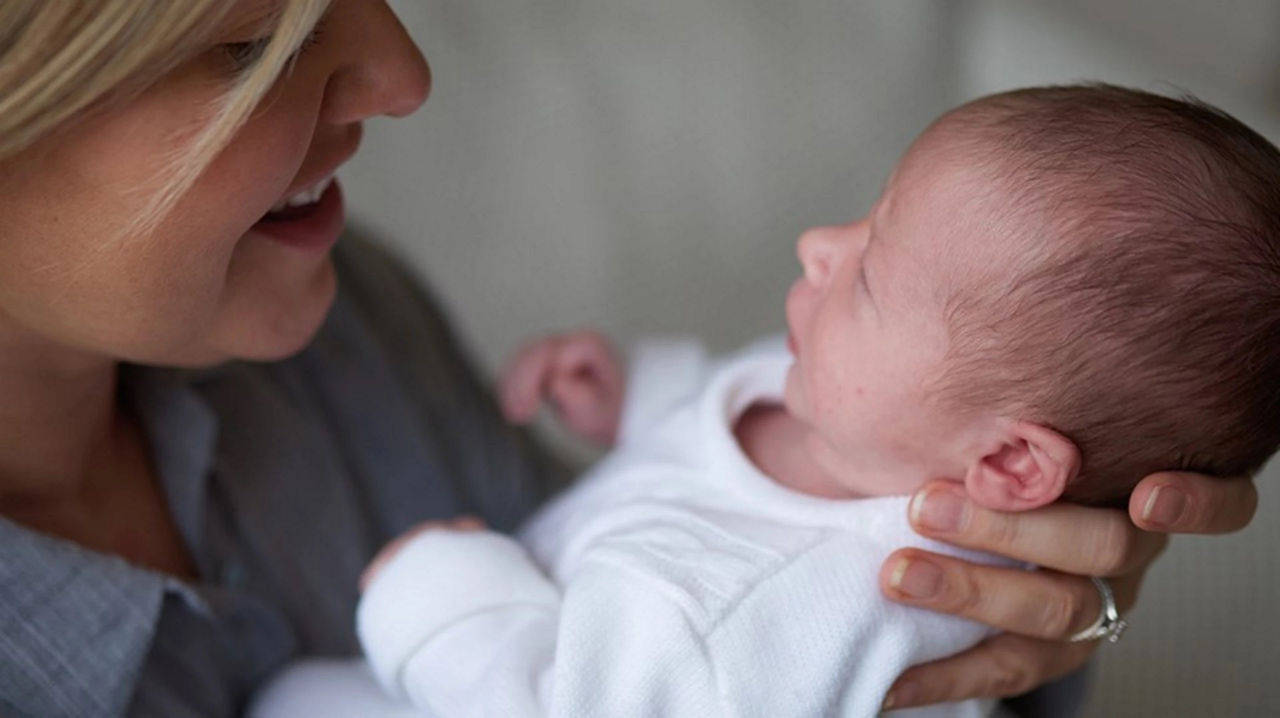Bottle feeding at your baby's pace
From exclusive breastfeeding to formula feeding, and everything else in between, there are a number of baby feeding options for you to consider. Bottle feeding, whether with expressed breast milk or infant formula, is just one of them.
If you decide to bottle feed, exclusively or in combination with breastfeeding, paced bottle feeding is a technique that has a number of benefits. Below you’ll find our guide to paced bottle feeding, including what it is, what the benefits are, and tips for success.

What is paced bottle feeding?
Paced bottle feeding, also known as responsive feeding, is a feeding technique that gives your baby more control over their feeds1, ensuring that they’re taking milk when they suck through the teat as opposed to air2. It’s intended to mimic the ‘paced’ way in which a breastfed baby would feed, which is by eating more slowly, taking small amounts of milk and taking short rests in between. Feeding this way allows the milk to stop flowing before they go back for more1.
Paced bottle feeding also mimics the closeness of breastfeeding. It involves holding your baby close, learning to recognise and follow their cues, and feeding them on-demand as opposed to following a set bottle feeding routine.
A guide to the paced bottle feeding technique
When your baby is ready to feed, hold them close to your body in an upright position. If your baby is laying on their back, it’s harder for them to control the flow of milk and how much they swallow. This may lead to them taking more than they need, which could lead to overfeeding.
Once you and your baby are comfortable1:
- Place the teat of the feeding bottle on your baby’s top lip and let them draw it into their mouth.
- Hold the bottle in a near-horizontal position, slightly tilted, for the duration of the feed. This will prevent the milk from flowing too fast into your baby’s mouth.
- Look out for a sign that they’re ready to take a break, and at that point, remove the teat from their mouth to give them time to rest - your baby will let you know if they want more. This can be a good opportunity to wind your baby if they appear restless and uncomfortable.
- Once your baby stops drinking, that may be a sign that they’re full and that you can end the feed.
If your baby gets upset when you remove the teat from their mouth, try putting it back in and tilting the bottle at a downwards angle. Doing this will slow the flow of milk down whilst providing your baby with some comfort as they feed1.
It’s important to never force your baby to finish all of the milk in their bottle, as this can lead to overfeeding and unnecessary weight gain. Rest assured that your baby will let you know when they’re hungry again.

What are the benefits of paced bottle feeding?
Paced bottle feeding brings with it plenty of benefits, both for you and your baby. In the first instance, it can help to reduce the risk of any stomach issues and discomfort your baby may have as a result of overfeeding - trapped wind being a good example2.
This bottle feeding technique can help you to recognise and respond to your baby’s feeding cues, so that you can let them take a break or stop when they need to. A further benefit of paced bottle feeding is the fact that it encourages the bonding process. As you feed, try looking into your baby’s eyes and holding them close, as this will help your baby to feel secure and calm.
How can paced bottle feeding support breastfeeding mums?
How you feed your baby is your own personal choice. There are many reasons, both physical and emotional, why you might consider a combination of breast and bottle feeding. You might be experiencing some breastfeeding challenges, mastitis for example, or have concerns about your breast milk supply. It might be that you'd like your partner or other family members to help with your feeding routine, particularly if you’re going back to work. Whatever the reason, the important thing is that it works for you and your family.
If you’re combi feeding your baby with both breast and bottle, paced bottle feeding provides for an easier switch between the two. Because paced bottle feeding mimics the way in which your baby breastfeeds, it can make for a smoother transition, and may help to avoid nipple confusion.
Feeding your baby is a great opportunity for you and your baby to spend time together and bond.
Bear in mind that health professionals recommend waiting until breastfeeding is fully established before you switch to any form of mixed feeding3, so be sure to discuss any changes you intend to make with your midwife or health visitor.
What is the best bottle for paced bottle feeding?
The type of feeding bottle you use is entirely up to you. There’s nothing to suggest that one type of bottle is better than another4.
Basic narrow and cylindrical bottles that come with their own lids and teats are both affordable and available. However, they sometimes come with narrow necks which can be harder to fill - particularly if you’re feeding on the go.
Whilst wide-necked bottles are easier to fill and clean, they’re also bigger, meaning that they take up more space in your steriliser. Wide necked bottles tend to come with teats that are made from silicone as opposed to latex, and they usually have a self sealing lid.
Finding the right bottle for your baby can be a case of trial and error until you find the one that suits the best. When making your choice, think about:
- How easy they are to clean - the simpler the bottle the easier it is to clean.
- Are they easy to assemble? Over complicated bottle designs may not be the best choice when it comes to night-time feeding.
- Are they easy to travel with? It’s important that you’re prepared for feeding on the go.
What is the best teat to use when paced bottle feeding?
There are so many varieties of bottle teats available that finding the right one can feel like quite the conundrum. Some teats however may be more suited to paced bottle feeding, for example those with a wider base and a shorter nipple. This is because they can hold enough milk when held horizontally without being tipped up and help to avoid your baby taking in excess air5.
In addition to the type of teat you decide to use, you’ll also need to think about the speed at which they allow the milk to flow from the bottle to your baby. Teats come in three main flow speeds; slow, medium and fast.
For paced bottle feeding, and for newborns generally, slow flow teats tend to be the preferred choice. They have a smaller number of holes in the teat, and hold enough milk when in an horizontal position. This allows the milk to flow more slowly into your baby’s mouth.
As your baby grows, you may find that you need to switch to a medium of faster flow teat, but always follow your baby’s lead here. Bear in mind also that the flow rate is not standardised across brands.
Over time, bottles and teats can get damaged. It’s important to check regularly for cracks and tears, and replace any damaged feeding equipment immediately.
Top tips for successful paced bottle feeding
Instead of following a set feeding routine, paced bottle feeding is based on following your baby’s lead, and feeding them as and when they’re hungry.
Below you’ll find a summary of our top tips for paced bottle feeding, to help make your feeding journey a success1, 2, 6:
- Use a bottle and teat with a slow flow rate, so that there is a more paced flow of milk as your baby feeds.
- Keep the bottle almost horizontal to the ground.
- Touch the bottle teat on your baby’s top lip. This will give them the opportunity to draw it to their mouth.
- When your baby’s sucking slows down, pace the feed by removing the bottle teat from their mouth. Allow them to draw it in again when they’re ready.
- Always check for signs that your baby needs a pause, or that they’ve finished feeding - remember to follow their lead.
- Stop the feed at regular intervals - this will give your baby control over how much milk they take.
- Take short breaks to wind your baby, to avoid any discomfort after a feed.
- If your baby feels unsettled when you remove the teat from their mouth, try tilting the bottle down with the teat still in their mouth to comfort them.
How do I stop my breastfed baby from drinking the bottle too quickly?
Babies need to use a different sucking action when feeding from the bottle to the one they use at the breast, so if you’ve been breastfeeding, it may take them a little while to adjust.
If you find that your baby is drinking too quickly from the bottle, this can lead to overfeeding, and even make them bring their milk back up. Paced bottle feeding can help here, as it allows your baby to control the flow of milk, and gives you the opportunity to follow their feeding cues.
The following can also help:
- Test the flow of the milk before starting a feed. If the milk is coming out too fast. You may need to try a slower flow teat.
- Hold your baby in an upright position and place the bottle horizontally and slightly tilted, close to their mouth, so that the milk flows more slowly.
- Allow your baby to take short breaks during feeding, and wind them regularly.
Related articles

Need some help?
You can get quick answers to common questions in our FAQs.
Alternatively, if you need help with general pregnancy or baby advice, or maybe on using or ordering our products - our expert team are always on hand to talk about feeding your baby.
- NHS Start for Life. Feeding on demand [online. Available at https://www.nhs.uk/start-for-life/baby/feeding-your-baby/bottle-feeding/bottle-feeding-your-baby/feeding-on-demand/#paced. [Accessed September 2023]
- NHS University Hospitals Sussex. Making the choice to bottle feed [online] 2023. Available at https://www.uhsussex.nhs.uk/resources/making-the-choice-to-bottle-feed-your-baby/#:~:text=Pace%20feeding%20is%20when%20you,with%20short%20pauses%20to%20rest. [Accessed September 2023]
- NHS Start for Life. Introduction to mixed feeding [online]. Available at https://www.nhs.uk/start-for-life/baby/feeding-your-baby/mixed-feeding/introduction-to-mixed-feeding/. [Accessed September 2023]
- NHS. Bottle feeding advice [online] 2021. Available at https://www.nhs.uk/conditions/baby/breastfeeding-and-bottle-feeding/bottle-feeding/advice/#:~:text=There's%20no%20evidence%20that%201,and%20sterilise%20are%20probably%20best. [Accessed September 2023]
- NCT. What bottles and teats do you need for babies? [online] 2021. Available at https://www.nct.org.uk/baby-toddler/feeding/practical-tips/what-bottles-and-teats-do-you-need-for-babies. [Accessed September 2023]
- NCT. Tips for bottle-feeding your baby [online] 2023. Available at https://www.nct.org.uk/baby-toddler/feeding/practical-tips/tips-for-bottle-feeding-your-baby#:~:text=Babies%20feed%20in%20bursts%20of,avoid%20over%2Dfeeding%20your%20baby. [Accessed September 2023].



